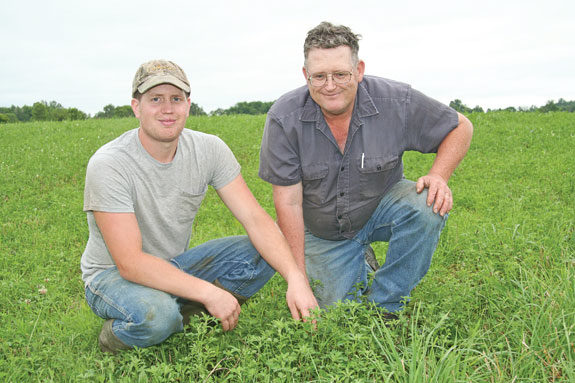The insect has been identified on more than 13 percent of New York state agricultural land across nine counties in northern New York.
Within the nine-county infested region, alfalfa stands are often destroyed in one to two years. The beetle was introduced into the state and North America at the port of Oswego between 1848 and 1896 in sailing boat ballast.
Snout beetle became a major pest problem after alfalfa was introduced in New York in the 1920s, eventually infesting 500,000 acres of agricultural land.
Attempts were made to control this insect from the 1940s to 1972 with the widespread distribution of poison bait. However, the snout beetle continued to spread.
Widespread baiting ended in 1972 due to environmental concerns, and the snout beetle population exploded in the early 1980s. Research focused on biological control to suppress the beetle was initiated in 1990.
The research breakthrough in control came out of Cornell University with long-term funding support from the farmer-led Northern New York Agricultural Development Program when entomologist Elson Shields found that using mixed species of entomopathogenic nematodes “can be a successful long-term biological control strategy.”
John Peck, who operates the 347-acre New York dairy farm that’s been in his family for 200 years, started noticing problems with his alfalfa crop about 1985.
“At first it looked like winterkill,” Peck says. “When I checked it out, I found root damage. Our approach for years had been to plant alfalfa seeded with oats and then plow it up and re-seed it in five or six years.
When we began noticing damage in the fields, we found that within a year after re-seeding the alfalfa, we were losing the alfalfa plants the second season. All we had left was grass.”
Signs of snout beetle infestation include patches that look like winterkill, plant upheaval, stand loss and severe root feeding.
After emergence in spring, adult snout beetles feed on alfalfa and clover foliage for about three weeks in May to build up fat reserves for their egg-laying cycle.
By June, the adults enter a non-feeding dispersal phase, with each insect laying as many as 500 eggs at the base of host plants. From June through November, snout beetle larvae feed on host plant roots.
Plants with heaviest damage begin to die in August. Plant death continues throughout the fall and winter months.
After completing larval development, larvae burrow deep into the soil during October and November. They pupate into adults the following summer.
Adults have a two-year life cycle and remain deep in the soil until the second spring, when they emerge in late April or early May.
Because the alfalfa in his fields provided high-quality forage for his dairy cows, Peck quickly saw milk production drop down 25 to 30 percent when they were killed out by the snout beetle.
By having to re-seed alfalfa fields more often, his production costs increased and his product output decreased.
“We tried a couple of control measures that didn’t work,” Peck says. “When Cornell started their research, they asked us if they could work on our farm to develop test plots. Of course we were happy to do that.”
Among the testing Cornell researchers conducted was use of different alfalfa varieties. Even though they tested nearly 80 different types of alfalfa, the beetle seemed to love them all.
Shields’ laboratory at Cornell discovered that native New York entomopathogenic nematodes were very effective in controlling snout beetle on the Peck farm.
About 10 years after they started their research, the snout beetle population collapsed and Peck was able to start raising alfalfa again.
Since the beetle came to the U.S. from Europe, Shields and one of his graduate students from Hungary traveled to that country to observe the insect in its native environment.
“That’s when they found the mix of entomopathogenic nematode species, a natural predator for insects in Hungary,” Peck says.
“The nematodes attack the beetle’s larva and dramatically reduce the insect populations below economic levels in fields. We’ve seen the effectiveness of the native nematodes on my farm.”
Among the benefits of using nematodes for control is the fact that one application can be effective for years. The nematodes can also be produced inexpensively ($50 to $75 for initial field introduction) using a rearing protocol developed by Shields’ laboratory.
A 30-page manual outlines how to raise the nematodes from starter cups and apply them to fields 14 to 18 days after the last alfalfa is cut.
The nematodes released from host insects are called infective juveniles. Sprayers are used to apply the nematodes, and the multi-cellular animal will continue to reproduce in the field naturally.
Cornell research support specialist Antonio Testa says the beetle hasn’t migrated south from the area where it was first identified in New York State. However, it has spread north and east in northern New York.
“Since the beetle is flightless, it is primarily moved through human activity, although the adults can be transported by floating in waterways,” Testa says.
“Movement of hay, soil, gravel and farm machinery have been identified as the primary methods of insect spread. In 1986, snout beetle was discovered across the St. Lawrence in Ontario, Canada.
It has since moved to Kempsville, Ontario. All these years it’s stayed above the Erie Canal and along the St. Lawrence River.
Only recently, it’s been seen in Canada. Certainly if a producer suspects their field might be infested, they should search for evidence of the beetle. If an alfalfa field was lush last year and is dying out now, that could be due to the snout beetle.”
Spread of the beetle generally goes unnoticed until populations are thriving in the new area.
“We usually don’t find the new infestations until the populations have built to a mass migration level of thousands of beetles and someone notices them,” Shields says.
“Rotating crops helps keep the population down, but snout beetle does well on Queen Anne’s Lace or wild carrot. It also does okay on dandelion, and there’s no shortage of dandelions where alfalfa is grown.
You almost need to rotate on a three-year basis to effectively control the beetle that way. Farmers really cannot do that economically.”
Another management focus has been development of snout beetle-resistant alfalfa varieties by the Cornell forage breeding program.
Researchers have worked closely with Shields’ laboratory. In 1998, many germplasm sources were evaluated for resistance to the beetle.
Statistically significant variation in resistance was found, suggesting that resistance genes may be present in a few alfalfa populations.

A greenhouse screening method was developed by Testa and Shields and has been used to screen more than 150,000 seedlings for snout beetle resistance.
As a result, a number of alfalfa populations have been selected, with varying degrees of resistance. Current field testing under natural conditions has shown that resistance is real in these lines and they show great promise.
More greenhouse screening/breeding is required before varieties can be released as fully resistant to the insect.
For more information about controlling the snout beetle, contact Tony Testa at (607) 591-1493 or email him at 28@cornell.edu or go online at www.nnyagdev.org FG
Loretta Sorensen is a freelance author from Yankton, South Dakota.
PHOTOS
TOP: After years of battling snout beetle and participating with a Cornell University research project, John E. Peck (right) and his son John D. “Jay” Peck now have fields lush with alfalfa.
MIDDLE AND BOTTOM: Students strain a mix of nematodes for application to the fields at Sheland Farms in Belleville, New York. Photos courtesy of Brian P. Whattam.









